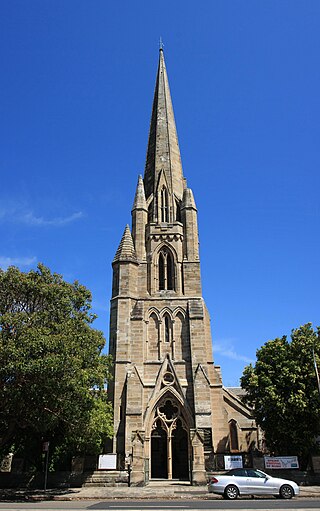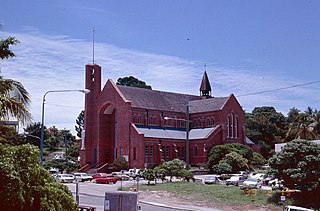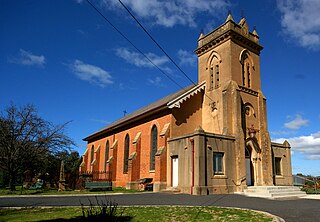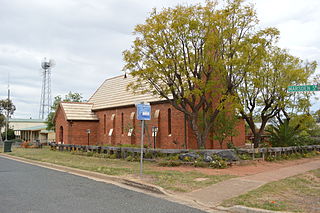
St Andrew's Cathedral is a cathedral church of the Anglican Diocese of Sydney in the Anglican Church of Australia. The cathedral is the seat of the Anglican Archbishop of Sydney and Metropolitan of New South Wales. The position of Dean of Sydney has been held by the Very Reverend Sandy Grant since 9 December 2021.
Edmund Thomas Blacket was an Australian architect, best known for his designs for the University of Sydney, St. Andrew's Cathedral, Sydney and St. Saviour's Cathedral, Goulburn.

The St Saviour's Cathedral is the heritage-listed cathedral church of the Anglican Diocese of Canberra and Goulburn in Goulburn, Goulburn Mulwaree Council, New South Wales, Australia. The cathedral is dedicated to Jesus, in his title of Saviour. The current dean is the Very Reverend Phillip Saunders. It was added to the New South Wales State Heritage Register on 20 April 2009.

The Hunter Baillie Memorial Presbyterian Church is a heritage–listed Presbyterian church, located in the inner western Sydney suburb of Annandale, New South Wales, Australia.

St James' Cathedral is a heritage-listed cathedral of the Anglican Diocese of North Queensland at 36 Cleveland Terrace, Townsville, City of Townsville, Queensland, Australia. It was designed by Arthur Blacket and was built in 1887 by MacMahon & Cliffe. It was added to the Queensland Heritage Register on 21 October 1992.

St John's Cathedral is a heritage-listed, Anglican cathedral in Parramatta, City of Parramatta, Sydney, New South Wales, Australia. St John's was given the status of provisional cathedral of the Anglican Diocese of Sydney in 1969, and designated a Regional Cathedral in 2011 for the Western Region. It was added to the New South Wales State Heritage Register on 5 March 2010.

The St Jude's Church is an active Anglican church in Randwick, a suburb of Sydney, New South Wales, Australia. It is part of a significant heritage group that includes the church, cemetery, rectory and original Randwick Borough Chambers, later converted to church use. The group is located on Avoca Street, Randwick, and has a federal heritage listing. It was added to the New South Wales State Heritage Register on 2 April 1999.

Vine Church is a vibrant inner-city church known for its warm community life, making it a great place to explore your doubts about God, Jesus, the Bible, and the meaning of life.

St Peter's Anglican Church is a heritage-listed Anglican church located at 187-209 Princes Highway, St Peters, in Sydney, New South Wales, Australia. It is one of the oldest churches in Sydney. Designed by Thomas Bird, the church is sometimes referred to as St Peter's Church, Cooks River, as it is located in the Anglican Parish of Cooks River, New South Wales. The church is listed on the NSW State Heritage Register and on the Register of the National Estate.

St Mark's Church is an active Anglican church in Darling Point, a suburb of Sydney, New South Wales, Australia. It is part of a significant local heritage group that includes the church, rectory, and adjacent cottage. The group forms part of a large collection of important to late 19th century buildings of considerable townscape, historic and cultural significance, including the former St Mark's Crescent School, St Mark's Cottage and Bishopscourt, formerly Greenoaks.

Holy Trinity Anglican Church is a heritage-listed Anglican church precinct, containing the church, rectory and adjacent cemetery, at 71-85 Gilmour Street, Kelso, Bathurst Region, New South Wales, Australia. The church was built from 1833 to 1878, with John Foster being responsible for the building of the original church. Edmund Blacket designed the rectory. The property is owned by Anglican Property Trust Diocese of Bathurst and Parish of Kelso, Anglican Diocese of Bathurst. It was added to the New South Wales State Heritage Register on 14 January 2011.

The All Saints' Anglican Church is a heritage-listed Anglican church located at McDonnell Street, Condobolin in the Lachlan Shire local government area of New South Wales, Australia. The church was possibly designed by Edmund Blacket and was built from 1878 to 1879 by Mr Brinsmead. It is also known as All Saints Anglican Parish Church. The property is owned by the Anglican Diocese of Bathurst. It was added to the New South Wales State Heritage Register on 2 May 2008.

St James' Anglican Church is a heritage-listed Anglican church precinct at 19 Tank Street, Morpeth, City of Maitland, New South Wales, Australia. The original design was attributed to Edward Charles Close, with later additions by Edmund Blacket and John Horbury Hunt and built from 1837 to 1875 by Edward Charles Close and James Sherwood. The precinct also includes the St. James' rectory and parish hall. The property is vested in the trustees of church property for the Diocese of Newcastle. It was added to the New South Wales State Heritage Register on 27 January 2017.

St Mary's the Virgin Anglican Church is a heritage-listed Anglican church at 66 Church Street, Maitland, City of Maitland, New South Wales, Australia. It was designed by Edmund Blacket. It was added to the New South Wales State Heritage Register on 2 April 1999.

St Stephen's Anglican Church is a heritage-listed Anglican church and cemetery at 187–189 Church Street, Newtown, Inner West Council, Sydney New South Wales, Australia. It was designed by Edmund Blacket and built from 1871 to 1874 by George Dowling and Robert Kirkham. The church is also known as St Stephen's Church Of England. It was added to the New South Wales State Heritage Register on 2 April 1999.

St John the Evangelist Church is a heritage-listed Presbyterian church located at Main Street, Wallerawang, City of Lithgow, New South Wales, Australia. It was designed by Edmund Blacket and Blacket and Sons, and built from 1880 to 1881 by George Donald. It is also known as the Church of St. John the Evangelist. It was added to the New South Wales State Heritage Register on 10 September 2004.

The Cathedral of the Annunciation of Our Lady is a heritage-listed former Anglican church and now Greek Orthodox cathedral located at 242 Cleveland Street, Redfern, New South Wales, Australia. The church was designed by Edmund Blacket and the rectory was designed by John Burcham Clamp and built from 1848. It is also known as the Greek Orthodox Cathedral; St Paul's Anglican Church; St Pauls Church of England; Cathedral of the Annunciation of Our Lady Theotokos. The property is owned by Greek Orthodox Archdiocese of Australia. It was added to the New South Wales State Heritage Register on 17 April 2012.

St Peter's Anglican Church is a heritage-listed Anglican church and associated Sunday school, rectory, and cemetery at 384 Windsor Street, Richmond, City of Hawkesbury, New South Wales, Australia. It was designed by Francis Clarke and Edmund Blacket and built from 1836 to 1841 by James Atkinson (church). It is also known as St Peter's Anglican Church Group, St Peter's Church Group, Church, Rectory, Church Yard, Cemetery and Stables. It was added to the New South Wales State Heritage Register on 16 August 2019; and on the City of Hawkesbury local government heritage register, and listed on the New South Wales Heritage Database on 12 September 2012.

St Johns Anglican Church Precinct, also known as St John's Camden, is a heritage-listed Anglican church and associated precinct at 6-22 Menangle Road, Camden, Camden Council, New South Wales, Australia. The precinct comprises the church, rectory, cemetery, two church halls and grounds that provide a rural landscaped environment to the group. The dominant feature of the precinct is the historic St John's the Evangelist Anglican Church. Its architects are unknown, and could be the cumulative work of Mortimer Lewis, John Cunningham and Edmund Blacket. It was built from 1840 to 1849 with Richard Basden responsible for the nave and John Le Fevre adding the spire. 1874 saw the addition of the chancel and vestry, their builder is unknown and the design is likely the work of Sir George Gilbert Scott and Blacket. A feature of the church is an organ manufactured by J. Bates & Son, London. The Anglican Church Property Trust of the Diocese of Sydney holds the property in trust, under the Anglican Church of Australia Trust Property Act 1917 (NSW). The precinct was added to the New South Wales State Heritage Register on 24 August 2018.























